|
FAQs on Anemone Identification
35
Related Articles: Anemones,
Bubble
Tip Anemones, LTAs, Cnidarians, Coldwater Anemones, Colored/Dyed Anemones,
Related FAQs: Anemone ID 1, Anemone ID 2, Anemone ID 3, Anemone ID 4, Anemone ID 5, Anemone ID 6, Anemone ID 7,
Anemone ID 8,
Anemone ID 9, Anemone ID 10, Anemone ID 11,
Anemone ID 12,
Anemone ID 13, Anemone ID 14, Anemone ID 15, Anemone ID 16, Anemone ID 17, Anemone ID 18, Anemone ID 19, Anemone ID 20, Anemone ID 21, Anemone ID 22, Anemone ID 23, Anemone ID 24, Anemone ID 25, Anemone ID 26, Anemone ID 27, Anemone ID 28, Anemone ID 29, Anemone
ID 30, Anemone ID 31, Anemone ID 32, Anemone ID 33, Anemone ID 34, Anemone ID 36, Anemone ID 37, Anemone ID 38, Anemone ID 39, Anemone ID 40, Anemone ID 41,
Anemone ID 42,
Anemone ID 43,
Anemone ID 44, Anemone ID 45,
& Cnidarian Identification, Anemones 1,
Anemones 2, Anemones 3, Anemones
4, Anemones 5, Invertebrate Identification, Aiptasia
Identification, Aiptasia ID
2, LTA
Identification, Bubble Tip
Anemones, Caribbean
Anemones, Condylactis, Aiptasia
Anemones, Other Pest
Anemones, Anemones and
Clownfishes, Anemone
Reproduction, Anemone
Lighting, Anemone Feeding,
Anemone Systems,
Anemone
Compatibility, Anemone
Selection, Anemone
Health, Anemone Behavior,
Anemone
Placement,
|
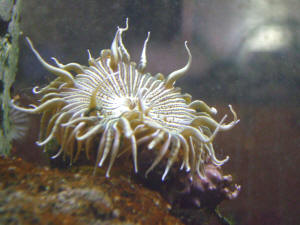
|
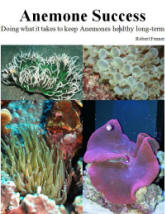 |
New Print and
eBook on Amazon:
Anemone Success
Doing what it takes to keep Anemones healthy long-term
by Robert (Bob) Fenner
|
|
BTA hitchhiker ID / Cleaner shrimp beh.
questions 4/25/10
Hello again crew!
<Terry>
Just wanted to thank you again for all your help and pick your
brains a bit more. I purchased a piece of live rock a the other
night and noticed today that there was a tiny Anemone floating
around.
The Anemone is only about the size of a nickle, so I caught it
and placed it in a net breeder so that my fish / hermit crabs
don't decide to eat it for lunch.
<Good>
It is flopped over right now but from what I can see it looks
like a rose bubble tip anemone.
<I can't really make this out>
Unfortunately I cannot tell if the foot is damaged or not.
I've attached a few pictures but I'm not sure
if you'll be able to make anything out of them. Will it be
able to restore its foot if I can manage to
"bring it back"?
<Only time can/will tell>
I know it is still alive because it moves its tentacles in and
out every so often.
Hopefully it will soon right it self, sit up straight and open
up
<Agreed>
In regards to feeding it, I've made a 50/50 blend of raw
shrimp and squid.
I cleaned the shells off the shrimp and took all the die / bony
structures out of the squid and passed it through a food
processor.
It now looks like sea food mush. Do you think that this is too
small?
<No, likely is fine. You should be able to see/discern if this
animal is reacting to, grabbing such food>
My second question is about my cleaner shrimp. It doesn't
seem to want to clean anymore... My emperor and
cream angel practically beg it to clean them but the shrimp
won't go anywhere near the angels anymore.
Is this normal?
<Does happen... In most cases due to their being so much,
otherwise available food/s>
I feed the fish just about every day, I skip a day or two every
so often.
Is the shrimp maybe eating so much fish food that it doesn't
need to clean in order to survive?
<This is probable>
Tank Setup / Parameters:
Ammonia 0
Nitrite 0
Nitrate somewhere between 0 and 5 ppm (test kit doesn't show
between 0 and 5)
about 80 lbs live rock
2 inches crushed coral substrate
Water temp 82
Salt reading on meter is 1.024 - 1.025
Lighting T5 HO and blue actinic (T5s are on between noon and
21:00 and the blue are on for 2 hours before and
after)
Livestock:
1 Emperor angel
1 Cream angel
1 Red Sea wrasse
1 Lawn mower Blenny
2 Ocellaris clowns
1 long spine urchin
1 cleaner shrimp
3 large hermit crabs
1 tiny anemone
Sorry about such a long email, and again for all your help!
Terry
<Welcome. BobF>
|
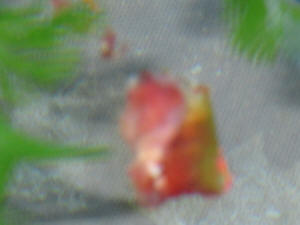 |
|
Sand Anemone Spawning: <RMF Help Please?>
4/18/10
Hi LynnZ,
Hi Crew ,
<Hello Claire, it's good to hear from you!>
Hope everybody is well there.
<Doing very well, thank you. I hope you're enjoying fine
health as well.>
I have a question about this sand anemone staying with me for two
months now.
<Neat, but I have to warn you, anemones are definitely not my
forte so it looks like we'll be learning together!>
Is there a chance that she releases eggs too
<If it's a female yes, otherwise it'll be sperm if
it's a male.><<Mmm, depending on the species may be
dioecious or monoecious... "one house"... both male and
female. RMF>>
(I think she can release both of them - not at the same time - if
she is hermaphrodite) or do I have to look for another sand
anemone to form a couple?
<Apparently they have separate sexes, so there would have to
be both male and female present in order to procreate
successfully.>
Could you please tell me the ID of this beautiful creature (I saw
a lot of pictures, but I'm still hesitating on the name).
<I wish I could because it is indeed a beautiful creature.
Unfortunately, I looked around but wasn't able to find an ID
(Bob, any ideas?).><<Unfortunately, no... I'd refer
Claire to Daphne Fautin's Hexacorallian site for more help:
http://hercules.kgs.ku.edu/hexacoral/anemone2/index.cfm
I attached a picture of the spawning.
<Love it, thanks!>
I saw her slowly raising on her feet and then she began. It was
beautiful. I closed skimmer and filter for a short time with the
futile hope she'll release eggs. She stopped spawning then
after 30 minutes approximately she began again for a shorter
period of time and she burrowed slowly again in sand. The whole
episode lasted for approximately one hour.
<Great observations, Claire.>
Thanks for answering, and for your patience.
<You're most welcome, but unfortunately, this is a
situation more likely to try your patience! What I could find
regarding the reproduction of tropical sand anemones (genus
Phymanthus) was limited but can be summed up as follows: they
have separate sexes but externally appear the same, some
broadcast spawn (females release eggs and males release sperm)
while other species' females (like Phymanthus crucifer) are
viviparous (bear live young/no eggs) and may brood them for a
bit, and finally, tropical species are more likely to reproduce
more often than temperate species. I wish I could offer more, but
that's the sum total.>
Take care and have a wonderful weekend.
<Thanks, you too!>
Claire
<Take care, Lynn Z>
|
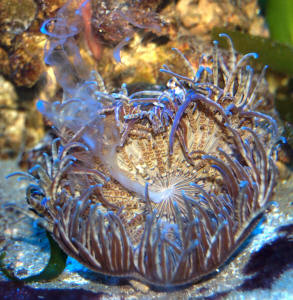 |
|
Anemone ID please? 4/14/10
Hi Crew,
(See attached pictures)
I received this anemone from a supplier last night,
inconveniently marked as "unknown anemone". Now I'm
not in the business of selling anything without knowing what it
is, so I've been trying to figure out what it is. It really
just doesn't seem like anything I've seen before, or any
images I have found. The orange base makes me think possibly a
/H. malu/?
<I agree>
I think it looks slightly like a /Condylactis sp./ but as far as
I'm aware we don't get them down here. Pretty much all
the info I can give you is that it was collected in Australian
waters, somewhere off the coast of Queensland.
Thanks heaps for your help,
Adam
<Is a beauty whatever it is. Bob Fenner>
|
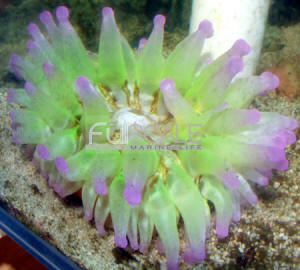 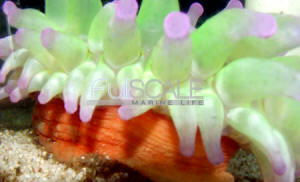 |
Anemone ID 4/8/10
<Hello>
I need help identifying some anemones. I have been wanting to get an
anemone for a while now but have not yet decided on which type I want.
Well I found a few that I like but after heavy researching I am either
lost with
confusion, because it could be any type of anemone, or all the
information I have researched does not have any information on these
types of anemone.
So I was wondering if you guys could help me id these anemone.
<First, I just don't have the time to watch all those videos as
we generally identify with a pic sent by the querior. Your number
"1" identifies itself as a Heteractis malu. Most anemones are
short lived/difficult to maintain as "heavy researching"
would have suggested, so I ask you read here and related
articles/FAQ's before purchasing, to ensure you have the system
capabilities, and the knowledge needed to maintain one.
http://www.wetwebmedia.com/marine/inverts/cnidaria/anthozoa/anemones.htm
The Bubble Tip Anemone (Entacmaea quadricolor) would be your/my best
choice for any long term success. Look here.
http://www.wetwebmedia.com/marine/inverts/cnidaria/anthozoa/bubbletipanemones.htm>
1. http://purelycaptivecorals.com/Heteractis%20Malu.html
2. http://www.youtube.com/watch?v=bIhfYq_GyfE
3. http://www.youtube.com/watch?v=cKP53sB0itI
4. http://www.youtube.com/watch?v=tToIa3SXqZU
5. http://www.youtube.com/watch?v=wf2T6muic1o
<James (Salty Dog)>
Re Anemone ID 4/7/10 4/8/10
Ok first off im <I'm> not stupid and for you to talk to me
like I am comes across as ignorant on ur <your> part and second
it's pretty obvious what the first anemone is as it states it on
the website however if you read my statement you wouldve <would
have> realized that I was also looking for information about the
anemone and more specifically I was looking for more information on
that pink white/yellow tipped anemone. Third these videos each were
really not that long if you really can't take a couple minutes to
watch a couple videos than maybe you should address that on your
website where everybody can see it.
<I did not imply that you were stupid. You did ask to identify the
five items mentioned, didn't you? You didn't state you knew
what the first one was. Secondly, we are not a 9 to 5 operation. We
volunteer our time on a daily basis and most of us limit our time to
one or two hours per day at most. If we spend too much time with one
query, then it doesn't leave much time to answer others. Do realize
that we get many queries daily.>
Im <I'm> thankful that you took the opportunity to read my
email however I am very displeased with the way you handled your
technique in replying to my message and can assure you that I will not
be coming back to your website. As well you don't know me so you
don't know if I have years of experience with anemone or if
I've researched the many different types of anemone thoroughly and
to ASSume that I have little experience and so rudely suggest that I
should just go with a Bubbletip would be very discouraging and
that's why most beginners are let down when they first start
because there's nobody to encourage them that they could eventually
work their way up to doing certain things in an aquarium such as
raising a malu anemone.
<Did not state experience level, but to have enough knowledge about
what you want to keep. I mentioned this because you did not state your
experience level. And, suggesting a Bubble Tip was not rude, it was
suggested because it is a specie that is one of the easier ones to
maintain, although none are easy, it is the least difficult to
keep.
Please read this article and you will get a better understanding of
what I'm talking about.
http://www.athiel.com/lib/questions/anemone.htm>
But anyways next time you write back to somebody hopefully you learned
that more customer service
<A customer is generally someone who buys a product or service. We
sell nothing here.>
and less laziness will benefit you in the ling <long> run.
<I do not benefit from volunteering my time other than having the
satisfaction that I may have helped someone. Hopefully after reading
this, you will understand, but after seeing your sign off below, it is
unlikely.
James (Salty Dog)>
Alrato nigga
Reply to a querior 4/8/10
Bob,
<James>
Can you take a look at my reply to a nasty querior? It's in the
draft folder. Just wanted to be sure I wasn't too rude before I
send this off.
Thanks,
James
<I think it's fine as is. B>
|
Anemone ID - 4/1/10
Hi Wet Web,
I was wondering if you could ID this anemone for me? I've
looked though the ID section but cannot find it. I've found
this anemone in the local fish store and its only being called a
sand anemone. It looks a bit like a Condy
but with very elaborate curls in each tentacle. The base is brown
and the tentacles go from vibrant pint to white, I've never
seen anything quite like it. Any ideas? and is this of the more
difficult variety to care for or about the same as a Condy.
kind regards
Lex
<I think this is a Macrodactyla doreensis... and a gorgeous
specimen!
Please read here: http://wetwebmedia.com/macrodoreensis.htm
and the linked files above re this species husbandry. Bob
Fenner>
|
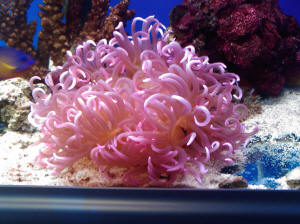 |
|
ID of a nem?
3/31/10
Hi, I have this nem & no one on the forums I belong to has
correctly identified it. Was wondering if any of you guys could.
It came as a hitchhiker about the size of a dime 7 months ago.
Now it is as big around as a baseball almost fully cover that
whole piece. Thanks for your help.
--
Michelle
Would you please send along a larger image... maybe 300 dpi,
500kbytes or so?
ID of a nem? 3/31/10
Hi, I have this nem & no one on the forums I belong to has
correctly identified it. Was wondering if any of you guys could.
It came as a hitchhiker about the size of a dime 7 months ago.
Now it is as big around as a baseball
<!?>
almost fully cover that whole piece. Thanks for your help.
--
Michelle
<This looks to be a Zoanthid... not an Actinarian/Anemone...
Please read here: http://wetwebmedia.com/zoanthid.htm
Unusual that it's so large though. Bob Fenner>
Re: ID of a nem?
3/31/10
ok I am camera illiterate, so I attached a photo bucket link.
maybe that will help. I'm sure its a nem, not a Zoa. I feed
it 2 jumbo Mysis every other day. Its a pig, oh and has a
mouth.
http://s479.photobucket.com/albums/rr152/michelle9491/?action=view¤t=005-11.jpg
<... this is a pic that includes a colony of an Octocoral...
is it the polyp in the upper left you're interested
in?>
http://s479.photobucket.com/albums/rr152/michelle9491/?action=view¤t=002-15.jpg
Hope this helps! Thanks
<... Please see where you were referred to... this
macroscopically is a Zoanthid. BobF>
|
 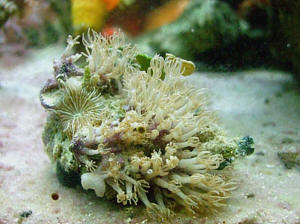 |
|
|

